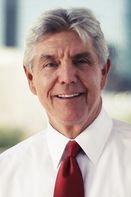Texas Democrats are as optimistic as they’ve ever been about candidate recruitment.
“I’ve been recruiting candidates in Texas for years, and I’ve never seen an environment quite like this,” said Cliff Walker, candidate recruitment director for the state Democratic Party.
Walker predicted that for the first time in his political career, every open congressional seat will be filled by a “strong Democratic nominee,” and many will have a Democratic primary.
One such race is the primary to challenge U.S. Rep. Roger Williams, R-Austin. His 25th Congressional District includes much of East Austin and parts of Central Austin, including the University of Texas. It stretches from western Hays County to the suburbs south of Fort Worth.
So far three Democratic candidates have emerged for the March primary, though there’s still time for others to join the race before the Nov. 11. deadline. All three cited Trump as their main motivator in deciding to throw their hat in the ring.
Kathi Thomas, 64, a Dripping Springs small-business owner, also challenged Williams in 2016. Initially, it was hearing Williams speak at a town hall-type meeting in 2014 that motivated her to run. After she lost to him last year with about 38 percent of the vote, she said, she hadn’t planned to run again.
[…]
Julie Oliver, 45, a St. David’s HealthCare executive and Central Health board member, never planned to enter the world of politics until Trump’s election, when she said she felt a call of duty.
“We need voices in Congress who will stand up to (Trump) and say that’s not OK. The way you speak is not OK. Where you’re leading us is not OK,” Oliver said, before naming Republicans in Texas and across the country who “won’t stand up to the bully” as she says she will.
[…]
It was seeing Trump announce the immigration ban that stirred to action Chetan Panda, a first-generation American whose parents came to the U.S. from India. Panda grew up and lives in Austin.
“You could see on CNN, these people who are not being allowed to be again in this country,” Panda said. “Honestly, I saw myself and my family’s faces on those people’s faces. … It was really opportunity being denied.”
Panda, 26, was working as a retirement fund manager at a mutual fund, but after that moment and careful consideration, he decided to leave the job to turn his focus on the congressional race.
Thomas was the only candidate of the three in CD25 to have filed a finance report for Q2. I didn’t include her in my roundup because she’d only collected about $8K. The deadline for Q3 reports was Sunday the 15th, and reports are starting to come in, so I’ll be very interested in what we get in this district. In the meantime, you can see Kathi Thomas’ webpage here, Julie Oliver’s here, and Chetan Panda’s here. You’ve got a range of options available to you if you live in CD25.
How good a target is CD25? It’s not completely hopeless, but it’s not exactly top tier. Here are relevant Presidential and Gubernatorial results from recent years, with Court of Criminal Appeals races thrown in for extra effect:
2016 – Clinton 39.9%, Trump 54.7% — Burns 37.0%, Keasler 58.1%
2012 – Obama 37.8%, Romney 59.9% — Hampton 37.6%, Keller 57.6%
2014 – Davis 39.5%, Abbott 58.3% — Granberg 36.4%, Richardson 58.9%
2006 – Molina 44.4%, Keller 55.6%
I didn’t include results from the weird 2006 Governor’s race. The more-encouraging 2006 CCA numbers are due to reduced Republican turnout, which was exacerbated in the downballot contests. Hope in all of these Congressional races begins with a combination of lessened Republican turnout plus energized Democratic participation, with some districts needing a higher concentration of each than others. If CD25 winds up being in play, we are on the high end of that scale.

